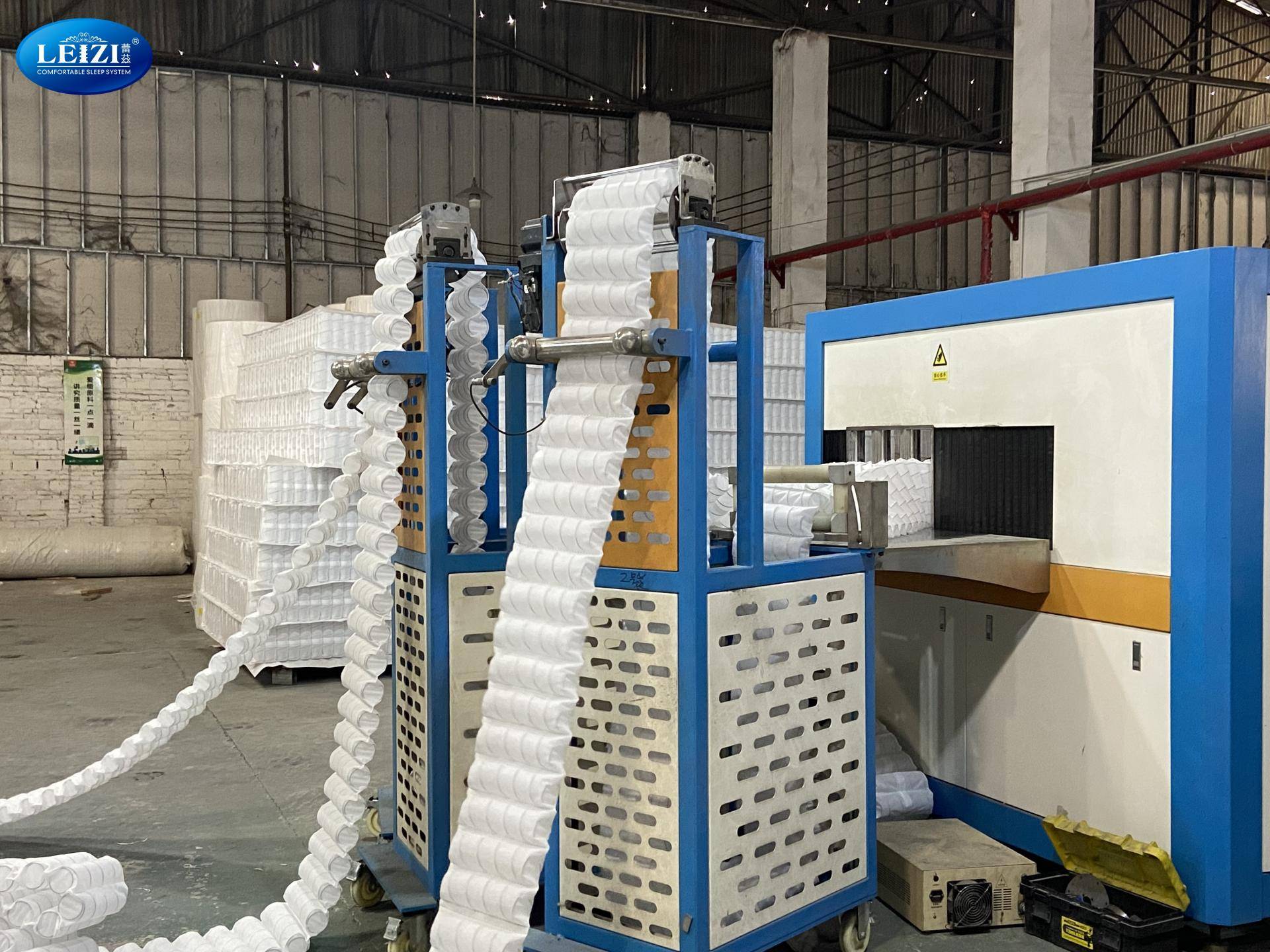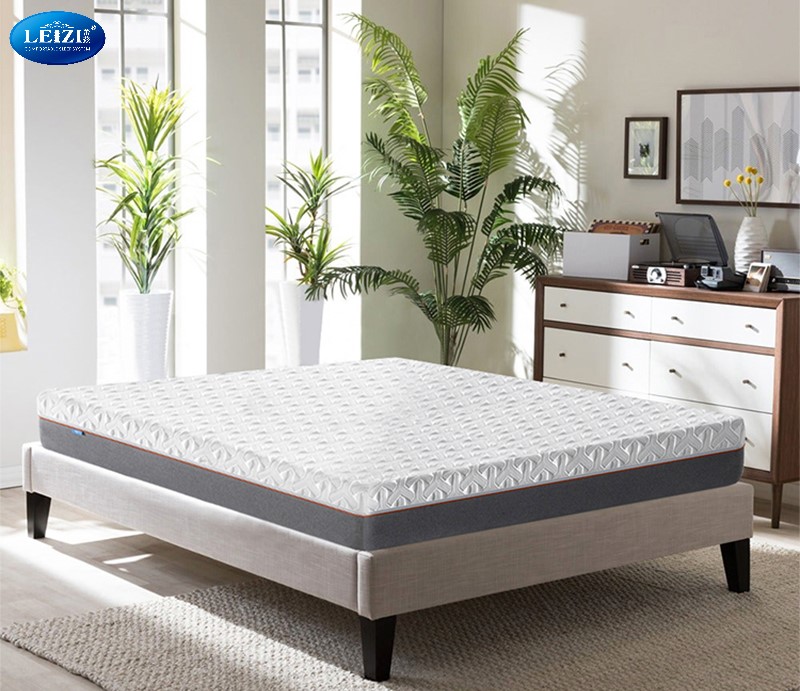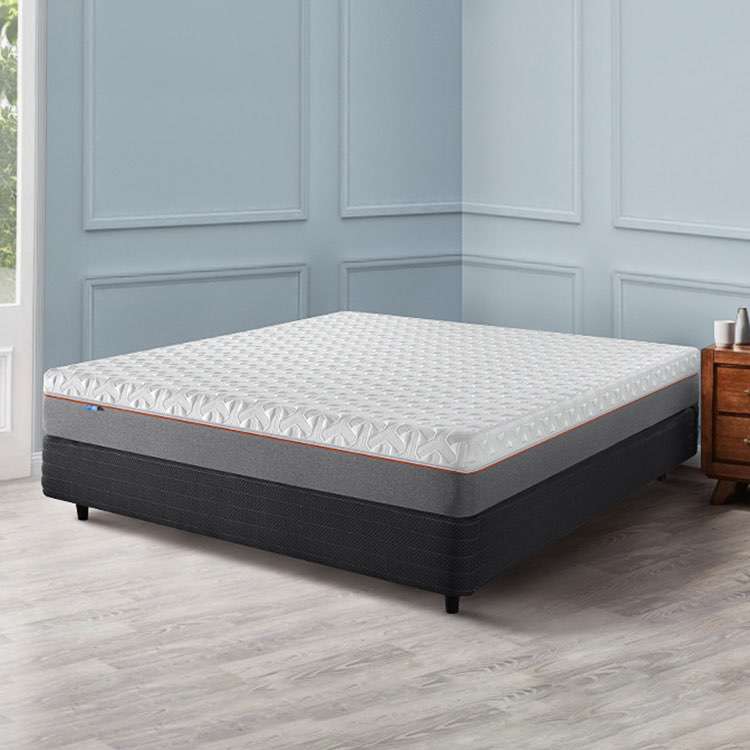Mattress Guide: How To Choose A Mattress
 FOSHAN LEIZI FURNITURE CO., LTD
FOSHAN LEIZI FURNITURE CO., LTD  April 29,2024
April 29,2024
In this fast-paced world, where stress and demanding schedules dominate our lives, a good night's sleep is crucial for rejuvenating our bodies and minds.
In the pursuit of excellence, we have researched and analyzed various types of mattresses, like spring matress, delving into their unique features and benefits. From the time-tested spring matress to the innovative memory foam and hybrid options, we've made it our mission to understand how each type, such as spring matress, can meet different sleeping preferences and requirements.

Sleeping position plays a pivotal role in determining the most suitable mattress for an individual,like spring matress. The mattress you choose, like spring matress, should adapt and conform to your body's natural curves, providing optimal support and pressure relief throughout the night. Whether you are a side, back, or stomach sleeper, we will guide you through the process of finding your dream mattress, like spring matress, that ensures a seamless transition into dreamland.
Beyond the realms of comfort, we will explore how different mattresses, like spring matress, can address specific concerns, such as back pain. If you suffer from back issues, we know firsthand the struggle of finding a mattress that truly eases discomfort and promotes proper spinal alignment. Together, we will uncover the therapeutic benefits of firm mattress with targeted support, allowing you to wake up feeling refreshed and ready to take on the day.
As a parent, we also understand the unique considerations that come into play when choosing a mattress like spring matress for children. Your child's growth and development are of utmost importance, and their sleep environment plays a pivotal role in supporting these aspects. We will share invaluable tips on selecting the ideal mattress, like spring matress, that ensures your little ones enjoy a safe and comfortable sleep every night.
Lastly, mattresses, like all things, have a lifespan. Over the years, we have witnessed the impact of proper mattress care on its durability. We will provide guidance on how to extend the life of your mattress, like spring matress, allowing you to maximize its benefits for years to come.
Through this comprehensive mattress guide, our aim is to empower you with the knowledge and understanding needed to make an informed decision when investing in your sleep quality. Join us on this journey of exploration and discovery, as we unlock the secrets to a blissful night's rest and pave the way for a healthier and happier you. So, let's dive in and embark on a restorative adventure to find the mattress like spring matress that perfectly suits you – your gateway to a world of peaceful slumber and rejuvenation.
Types of Mattresses
Choosing the right mattress is a crucial decision that can significantly impact the quality of your sleep and overall well-being. With a wide array of mattress types available on the market, like spring matress, it can be overwhelming to navigate through the options. We will explore the various types of mattresses, like spring matress, each with its unique features and benefits, to help you make an informed choice.
1.Spring Mattresses:
Spring mattresses, also known as innerspring mattresses, have been a staple in the bedding industry for decades. Spring matress is constructed with a core of metal coils that provide support and resilience. The number, thickness, and distribution of the coils can vary, affecting the spring matress's overall comfort and support level. The presence of springs offers a responsive feel, making it easy to change positions during the night. Additionally, spring matress tends to have good airflow, promoting a cooler sleep environment, which can be especially beneficial for hot sleepers.
2.Memory Foam Mattresses:
Memory foam mattresses have gained immense popularity in recent years due to their ability to conform to the sleeper's body shape, providing excellent pressure relief. Memory foam is sensitive to heat and pressure, allowing it to mold around the contours of your body while distributing weight evenly. This characteristic makes memory foam ideal for relieving pressure points and promoting proper spinal alignment, making it a top choice for individuals with chronic pain issues. Additionally, memory foam mattresses are excellent at isolating motion, reducing disturbances caused by a restless sleeping partner.

3.Latex Mattresses:
Latex mattresses are crafted from natural or synthetic latex, offering a bouncy and responsive feel similar to spring maress. Natural latex mattresses are hypoallergenic, antimicrobial, and resistant to dust mites, making them an excellent option for allergy sufferers. Latex mattresses also provide good support and pressure relief, catering to a wide range of sleep preferences. They are known for their durability, with some high-quality latex mattresses lasting for over a decade.
4.Hybrid Mattresses:
Hybrid mattresses combine the best features of different materials to offer a balanced sleep experience. Typically, a hybrid mattress consists of a combination of memory foam or latex layers along with pocketed coils or innerspring technology. The goal is to maximize the benefits of each material while minimizing potential drawbacks. Hybrid mattresses often provide the contouring and pressure relief of memory foam or latex, coupled with the support and responsiveness of springs.
5.Airbed Mattresses:
Airbed mattresses feature air chambers that can be adjusted to control the firmness level. With the ability to customize the mattress's firmness, airbeds are an excellent option for couples with different sleep preferences or individuals who like to modify their sleep surface based on changing needs. Some advanced airbeds come with dual-zone settings, allowing personalized firmness on each side of the bed.
6.Adjustable Beds:
Though not a type of mattress per se, adjustable beds deserve mention for their significant impact on sleep quality. These beds have a multi-hinged surface that can be adjusted to elevate the upper body, lower body, or both. They are especially beneficial for individuals with certain medical conditions or those who prefer to read, watch TV, or sleep in an elevated position.
In conclusion, the wide variety of mattress types available today ensures that there is a suitable option for every individual. Each mattress type ,like spring matress, caters to specific sleep needs and preferences, so understanding their unique characteristics is essential for making an informed decision. Consider factors such as body support, pressure relief, motion isolation, and temperature regulation to find the mattress that best suits your sleep requirements and offers you a night of deep, restorative sleep.
Which Mattress Type is Best?
When it comes to determining the best mattress type,like spring matress, there is no one-size-fits-all answer. The ideal mattress varies from person to person, depending on individual preferences, sleep positions, and specific health considerations. Let's explore the key attributes of different mattress types, like spring matress, to help you understand which one might be the best fit for you.
1.Spring Mattresses:
Spring mattresses are well-suited for individuals who prefer a traditional and bouncy feel. The presence of metal coils in the spring matress provides sturdy support and ensures proper spinal alignment for back sleepers. However, spring matress may not offer enough contouring for side sleepers, potentially causing pressure points.
Best for: Back sleepers, individuals who prefer a responsive feel, and those on a budget seeking a durable spring matress.
2.Memory Foam Mattresses:
Memory foam mattresses excel at contouring to your body shape, providing unparalleled pressure relief. This material adapts to your curves and distributes weight evenly, which is particularly beneficial for side sleepers and people with joint or back pain. Memory foam also minimizes motion transfer, making it an excellent choice for couples.
Best for: Side sleepers, individuals with chronic pain issues, and anyone seeking exceptional pressure relief and motion isolation.
3.Latex Mattresses:
Latex mattresses offer a buoyant and responsive surface, akin to a spring matress, but with the added benefits of pressure relief and durability. Natural latex mattresses are an excellent choice for eco-conscious consumers, as they are made from sustainable materials.
Best for: Combination sleepers, those who prefer a bouncy feel with good support, and individuals with allergies.
4.Hybrid Mattresses:
Hybrid mattresses combine the advantages of different materials, making them a versatile option suitable for a wide range of sleepers. By incorporating memory foam or latex layers along with pocketed coils or innerspring technology, hybrids offer a balanced sleep experience, catering to various preferences.
Best for: Sleepers who want the benefits of multiple materials in one mattress, couples with differing sleep preferences, and individuals seeking a blend of support and contouring.
5.Airbed Mattresses:
Airbeds are an excellent choice for those who prefer customizable firmness levels. With adjustable air chambers, you can fine-tune the feel of the mattress to suit your comfort needs. This makes airbeds an attractive option for sleepers with specific firmness preferences or health conditions.
Best for: Couples with different firmness preferences, people with changing sleep needs, and those seeking adjustable support.
Ultimately, the best mattress like spring matress for you is the one that aligns with your unique sleep requirements and preferences. Consider factors such as your favored sleep position, body weight, potential health concerns, and personal preferences for firmness and material. Many mattress retailers offer trial periods, allowing you to test the mattress like spring matress in the comfort of your home before committing fully. Take advantage of these trials to find the mattress that offers you the best sleep experience, providing the foundation for a well-rested and rejuvenated life.
Choosing the Right Mattress for Your Sleep Position
Understanding your preferred sleep position is essential for selecting a mattress that provides optimal support and comfort,such as spring matress. Each sleep position places different demands on the body, and choosing the right mattress can significantly impact your sleep quality. Let's explore how different mattress types cater to specific sleep positions:
1.Side Sleepers:
Side sleepers often require a mattress that offers ample contouring to cushion their shoulders and hips, aligning the spine in a natural position. Memory foam mattresses excel in this aspect, as they conform closely to the body's curves, alleviating pressure points and ensuring a cozy sleep surface. Hybrid mattresses, with their combination of memory foam or latex and supportive coils, also provide a good balance of contouring and support for side sleepers.
2.Back Sleepers:
Back sleepers benefit from a mattress that maintains the natural curve of their spine and prevents sinking into the bed too deeply. A medium firm spring matress is typically recommended for back sleepers, as it provides sufficient support while conforming to the body's shape. Latex mattresses, with their buoyant and responsive feel, can be an excellent choice for back sleepers, offering comfort and alignment.
3.Stomach Sleepers:
Stomach sleepers should aim for a mattress that keeps their hips from sinking too far into the bed, as this can strain the lower back. A firm mattress is generally recommended for stomach sleepers to maintain proper alignment. Hybrid mattresses or firmer memory foam mattresses can provide the necessary support and prevent excessive sinking.
4.Combination Sleepers:
If you frequently change positions during the night, a medium firm hybrid mattress can be an ideal choice. The combination of memory foam or latex with pocketed coils offers a responsive surface that adapts to your movements, ensuring consistent support and comfort, no matter your sleep position.
Remember, personal preference also plays a role in choosing the right mattress, like spring matress. While certain mattress types may be better suited for specific sleep positions, finding the perfect fit depends on how comfortable and supported you feel while lying on it. Take the time to try different mattresses and assess how they align with your sleep style, ensuring you find the perfect match for restful nights and rejuvenated mornings.
How to Choose a Mattress to Address Back Pain
If you suffer from back pain, your choice of mattress, like spring matress, can significantly impact your comfort and sleep quality. The right mattress, such as spring matress, can provide much-needed support, alleviate pressure points, and promote spinal alignment, helping you find relief from back pain. Here are some key factors to consider when choosing a mattress to address back pain:
1.Firmness Level:
Contrary to popular belief, an ultra firm mattress is not always the best choice for back pain. Instead, a medium firm to firm mattress is often recommended, as it strikes a balance between support and comfort. This level of firmness can keep the spine properly aligned without creating excessive pressure on sensitive areas.
2.Material:
Memory foam mattresses are frequently favored by individuals with back pain due to their exceptional contouring properties. The material conforms to your body, cradling the natural curves of your spine and reducing pressure on the lower back. Latex mattresses also provide good support and responsiveness, making them another viable option for back pain relief.
3.Lumbar Support:
Some mattresses are designed with specific lumbar support zones, providing extra reinforcement for the lower back region. Look for mattresses with targeted support in the lumbar area to maintain a healthy spinal alignment and alleviate discomfort.
4.Motion Isolation:
If you sleep with a partner, motion isolation is essential to prevent disturbances from their movements. Memory foam and latex mattresses are particularly effective at isolating motion, allowing you to rest undisturbed, even if your partner moves during the night.
5.Trial Periods:
Many mattress retailers offer trial periods, allowing you to test the mattress in the comfort of your home. Take advantage of these trials to determine if the mattress alleviates your back pain and provides the support you need.
By taking these factors into account and consulting with your healthcare professional if necessary, you can make an informed decision on the best mattress to address your back pain, like spring matress. Remember that everyone's body is unique, so it's essential to find a mattress that meets your individual needs and promotes a restful, pain-free night's sleep.
How to Choose a Mattress for Children
Selecting the right mattress for your child is vital for their growth, development, and overall well-being. Children require adequate and restful sleep to support their physical and cognitive development, making the choice of a mattress even more crucial, like spring matress. Here are some essential factors to consider when choosing a mattress for your child:
1.Firmness and Support:
While adults may prefer various firmness levels, children generally benefit from a medium firm mattress. A spring matress that is too soft may not provide adequate support for their growing bodies, potentially leading to back pain or posture issues. A medium firm mattress offers the necessary support while remaining comfortable for your child's sleep.
2.Material and Safety:
Opt for materials that are safe and hypoallergenic. Natural latex or high-quality memory foam mattresses are excellent options, as they are often free from harmful chemicals and resistant to dust mites and allergens. Look for spring matress with CertiPUR-US® or similar certifications, ensuring they meet safety and environmental standards.
3.Temperature Regulation:
Children are more sensitive to temperature changes, so choosing a mattress with good breathability and temperature regulation is essential. Look for spring matress with cooling properties, such as gel-infused memory foam or breathable materials, to help keep your child comfortable during hot nights.
4.Waterproof and Easy-to-Clean Cover:
Accidents are common during childhood, so consider a spring matress with a waterproof and removable cover. This will protect the mattress from spills, stains, and other mishaps, making it easier to maintain and prolong its lifespan.
5.Longevity and Durability:
Invest in a high-quality spring matress that will last throughout your child's growth years. A durable mattress, such as spring matress, can provide comfort and support for an extended period, ensuring your child gets a good night's sleep as they transition from a toddler to a teenager.
6.Edge Support:
If your child tends to sit or play on the edge of the bed, look for a mattress with reinforced edge support,like spring matress. This feature helps maintain the spring matress's shape and prevents premature sagging, ensuring consistent support across the entire sleep surface.
7.Consider Your Child's Preferences:
Involve your child in the mattress selection process, considering their preferences and comfort levels. If possible, let them try lying down on different mattresses, like spring matress, to see which one they find most comfortable.
Remember that children grow rapidly, and their sleep needs evolve over time. It's a good idea to reevaluate their mattress every few years to ensure it still meets their changing requirements. Additionally, invest in a high-quality mattress protector to guard against spills and stains, extending the spring matress's life and maintaining its hygiene.
By considering these factors and involving your child in the decision-making process, you can choose a mattress, like spring matress, that provides the support, comfort, and safety necessary for their healthy development and restful sleep. A well-chosen spring matress can make a significant difference in your child's sleep quality and overall well-being as they grow and flourish.
How Long Should a Mattress Be Used?
The lifespan of a spring matress is an important consideration, as it directly impacts your sleep quality, comfort, and overall health. While spring matress is not designed to last forever, understanding their typical lifespan and signs of wear can help you determine when it's time for a replacement. Here's what you need to know about how long a mattress should be used:
1.Average Lifespan:
On average, a spring matress can last between 7 to 10 years. However, this can vary depending on several factors, including the quality of the mattress, materials used, usage, and maintenance. Higher-quality spring matress with durable materials tend to last longer than lower-quality ones.
2.Mattress Type:
Different mattress types have varying lifespans. Spring matress and hybrid mattresses, which use coils, tend to have a slightly shorter lifespan compared to memory foam or latex mattresses. Memory foam and latex mattresses can retain their comfort and support for more extended periods due to their resilient materials.
3.Weight and Usage:
The weight and usage of the spring matress can impact its durability. A heavier individual or one who frequently sits or stands on the mattress may experience more wear and tear, reducing the mattress's longevity. Additionally, spring matress used in guest rooms or less frequently may last longer than those used daily.
4.Signs of Wear:
As a spring matress ages, it may show visible signs of wear and tear. These signs include sagging, indentations, lumps, or unevenness. If you notice these issues, it may be an indication that the spring matress is no longer providing adequate support and comfort.
5.Changes in Sleep Quality:
If you find yourself waking up with aches, pains, or feeling unrested despite getting enough sleep, it could be a sign that your spring matress is past its prime. An old and worn-out mattress may no longer provide the necessary support and pressure relief, leading to discomfort and disrupted sleep.
6.Allergies and Hygiene:
Over time, mattresses can accumulate allergens, dust mites, and bacteria, potentially exacerbating allergies and affecting your sleep quality. Regularly cleaning and maintaining your spring matress can help, but eventually, a replacement may be needed for improved hygiene and health.
7.Mattress Warranty:
Many reputable mattress manufacturers offer warranties that cover specific defects or issues for a designated period. However, it's essential to note that the warranty period does not necessarily indicate the mattress's overall lifespan. Instead, it provides protection against manufacturing defects.
While mattresses have a finite lifespan, there are various factors to consider when determining how long a mattress should be used. Regularly evaluating the mattress's condition, sleep quality, and signs of wear can help you decide when it's time to invest in a new one. Remember that a comfortable and supportive mattress like spring matress is crucial for achieving restful sleep and maintaining your overall well-being. By replacing your mattress at the appropriate time, you can ensure a better sleep environment and enjoy the benefits of a rejuvenating night's rest.
Conclusion:
Choosing the perfect mattress like spring matress goes beyond personal preference; it is about finding the right balance of comfort and support for your unique needs. Whether you prefer a spring matress for its responsiveness or a memory foam option to contour to your body, understanding your sleep position and back health can guide you towards making the best choice. When it comes to children, investing in a quality mattress, like spring matress, that supports their growth and development is essential. Remember, a well-maintained mattress, such as spring matress, can provide many restful nights, contributing to your overall well-being and quality of life.
FAQ
1. What are the different types of mattresses available?
There are various types of mattresses, including spring matress, memory foam mattress, latex mattress, hybrid mattress, airbed mattress, and adjustable beds.
2. Which mattress type is best for my sleep position?
The best mattress type depends on your sleep position. Side sleepers may benefit from memory foam or hybrid mattresses for pressure relief, back sleepers may find comfort on latex mattresses, stomach sleepers may prefer a firmer mattress, and combination sleepers may enjoy the adaptability of a medium firm hybrid mattress.
3. How can I choose a mattress to address back pain?
For back pain relief, consider a medium firm to firm mattress with memory foam or latex for contouring support. Look for mattresses with targeted lumbar support and motion isolation to reduce disturbances during sleep.
4. How do I choose a mattress for my child?
Choose a medium firm mattress with safe materials like natural latex or high-quality memory foam or spring matress. Opt for a waterproof and easy-to-clean cover for accidents. Consider temperature regulation and edge support, and involve your child in the selection process for their comfort preferences.
5. How long should a mattress be used before replacing it?
The average lifespan of a mattress is 7 to 10 years, like spring matresss, but this varies depending on the type, usage, and maintenance. Monitor for signs of wear, changes in sleep quality, and hygiene issues. Regularly clean and maintain your mattress and consider replacing it when it no longer provides adequate support and comfort.











